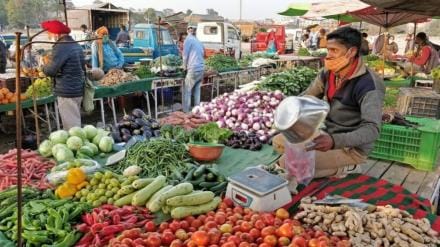Economists hailed India’s Consumer Price Index (CPI) based inflation moderating to a three-month low of 5.02 per cent in September from 6.83 per cent in August. The higher than expected decline has put the Reserve Bank of India (RBI) in favour of not going for any rate hike for the rest of FY24 with complete divergence from US Fed, prioritising growth. “CPI print for September at 5.02 per cent is lower than expectations. The sharp dip in vegetable inflation has paved the way for the CPI inflation to come within the RBI’s comfort band of 2-6 per cent. The take away from this low number is that the MPC will opt for a pause for the rest of FY24 and go for a rate cut in Q2 of CY24,” said Dr VK Vijayakumar, Chief Investment Strategist, Geojit Financial Services.
“Though we don’t expect any rate hike this fiscal, RBI will actively manage inflationary pressure through its liquidity measures,” added Rajani Sinha, Chief Economist, CareEdge Ratings.
Ranen Banerjee, Partner, Economic Advisory Services, PwC India, added, “Good news is that the core inflation – excluding fuel and food – has gone below 5 per cent. We can expect the policy rates to remain unchanged for quite some time – at least till Q1 of FY25 – given the inflation prints in coming months will face upward pressure risks from the possible lower farm outputs owing to uneven rain experienced during monsoons. Global crude prices remaining elevated owing to production cuts, Chinese impetus and geopolitical flare ups will put further pressure on the inflation front.”
Dipti Deshpande, Principal Economist, CRISIL, said that the RBI will stay vigilant and actively manage inflationary pressure through its liquidity measures. “We expect the RBI to look through the September quarter hump but stay vigilant since headline inflation remains much above the Monetary Policy Committee’s (MPC) 4 per cent target and risks are tilted on the upside due to the flare-up in crude oil prices. For this fiscal, in the base case, we expect inflation to average 5.5 per cent and expect the MPC to maintain the policy rate and stance.”
According to data released by the National Statistical Office, the decline in retail inflation occurred mainly on account of a sequential crash in prices of vegetables, particularly tomatoes, and cooking gas (LPG), but the base effect also helped. Core inflation, which excludes volatile components of food and fuel, declined to a 42-month low of 4.5 per cent in September, indicating broad-based easing of underlying price pressures.
The vegetables index, which carries a weight of 6 per cent in the CPI basket, plunged 15.8 per cent month-on-month in September, the steepest pace in 33 months. The tomatoes’ index within vegetables plummeted 64.9 per cent on month. The prices of tomatoes that skyrocketed in July on account of supply disruptions corrected sharply in September with the advent of fresh arrivals in the market. However, price pressures for cereals, pulses and spices, which are more persistent in nature, remained elevated. Rajani Sinha from CareEdge Ratings, said, “With the arrival of fresh agri produce in market October onwards and expected moderation in fuel inflation, the CPI inflation is likely to fall further.”
“Food prices were the key driver leading to higher CPI print last month, which has eased considerably in September 2023. Adequate supply and supply from government storages led to downward pressure on food prices. However with a dry spell in October, rising El Nino situation and increase in global crude prices, inflation may remain sticky for some time,” said Vaibhav Shah, Fund Manager, Torus Oro PMS.
Weak kharif sowing, crude oil prices due to Middle East conflict to play spoilsport
While the CPI inflation eased to a three-month low in September, economists and experts said that weak sowing in key kharif crops and crude oil prices could play spoilsport if the Middle East conflict escalates. “There is pressure from crude oil now, with prices rising following the Middle East conflict. This will put pressure on the non-food component of inflation, which played a big role this year in bringing down the headline print from its peaks. For the December quarter, we expect some softening in food inflation with the kharif harvest entering the market along with government intervention. But there could be limited respite for pulses and cereals inflation. Crude oil could play spoilsport if the Middle East conflict escalates. These are the risks to watch out for,” said Dipti Deshpande.
Upasna Bhardwaj, Senior Economist, Kotak Mahindra Bank, said, “We estimate FY2024 CPI inflation at 5.2 per cent (5.4 per cent earlier) noting upside risks from a tight oil market and weak sowing in key kharif crops. We maintain our view of a prolonged pause by the RBI, with system liquidity likely to remain tight in the near term.”
Meanwhile, talking about the impact of the inflation print on the fintech sector, Rohit Arora, CEO and Co-founder, Biz2Credit and Biz2X, said, “For the fintech sector, it means a more predictable environment for interest rates and lending conditions, setting the stage for continued growth and innovation. With the Israel-Hamas conflict raising oil price concerns, especially if the strife extends across the broader Middle East, we remain cautiously optimistic about the future and will continue to adapt to the evolving financial landscape for the benefit of our customers.”
